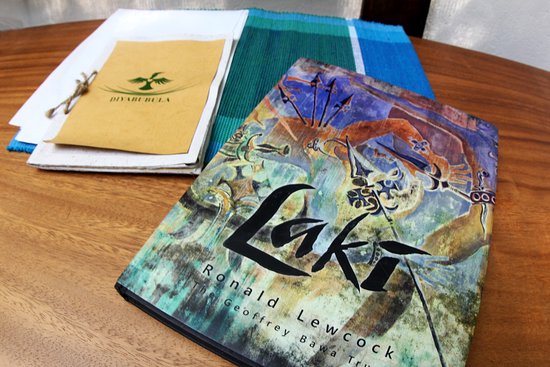A critical review of the book ‘Laki,’ published by the Geoffrey Bawa Trust with an introduction by Ronald Lewcock By John Peponis
In this book of his life and work, the drawings and the paintings come across as so spontaneous, so driven by the muscular force of the moment, that one could forget that imagination is never purely visual but also conceptual. So, the Butterfly on page 53 looks like a flower, quite a natural affinity to reconstruct through brushstrokes. However, the Topography of a butterfly wing, page 144, works as a counterpart: in depicting the merging of forms and the blurring of contours during flutter from one position to another, it acknowledges, through the use of the conventions of contour maps, the intellectual mediation of perception.
The theme of Ovidian metamorphoses offers an immediate point of entry in analysing the work. How many birds are there in Sinharaja forest with Trogon, page 58? Why isn’t the human figure being protected mentioned in the title of Owl with Snake, page 154? The Botanical Unicorn, page 105, comes as confirmation that things of one kind can be arranged to suggest the shape of things of quite another kind. Shape, material and substance refuse to settle into the familiar beings named in language. Fluidity demands attention The fluidity that runs through the metamorphoses demands its own kind of attention.
In Ficus, Peradeniya Gardens, pages 138-139, the sky and the earth, linked by the branches and roots of the tree, are distinct. The white page comes across as light through the leaves in the upper part; the gestures of drawing the individual leaves are, in principle, countable. Darkness takes over the lower part and the gestures that produced the hatching are so dense that they are only countable by patches. Thus, the roots appear as white figures on dark background, while the leaves are black delineations on white background. But if this ink drawing, for all its meticulous skill, projects to our standard interpretation of tree, things are quite different in China Bay. Trincomalee, page 32. Here, all definite form seems provisional. Water, sand and leaves are all fluid; there is only one rock to suggest that the net of branches may not itself be without ground. Implicit forces Implicit in metamorphoses are forces, present even when there is no explicit movement. In the work of Laki there are forces in abundance, often in multiple layers, like curtains that require one to look through.
This is perhaps most evident in Dry Zone, page 131, which equivocates between representing the mere trace of force and presenting an image, between expansive desire and constriction, between human and animal figures, between interment and dematerialisation. But of course, an architect would be drawn in particular to the sculptured handrail in the Lighthouse Hotel at Galle, where forces are, first of all, expressed in movement. Stairs are the places in buildings where one is most aware of body and one’s own movement, but here the stair is additionally used to stage a narrative of motion. One knows from Homer that the description of battle scenes requires the narrator to shift from a ‘close-up’ to a panoramic view, from the single confrontation to many others occurring simultaneously, from the effort to capture coordination to the acknowledgment of disorder, from unity to multiplicity. Similarly, the circular stair affords Laki a natural way to create shifting relationships of foreground and background, focus and overview, frontality and obliqueness.
The gaze of visitors shifts from the proximate figure to a more distant one, from the part of the battle procession that immediately borders their path to the part set in circular orbit at a distance. And of course, the difference between ascent and descent, already measurable by the amount of effort required, is here accentuated not only by the contrast between light, above, and shadow, below, but also the way in which one crosses the force fields of the weapons held by the soldiers or the gazes implied by their hollowed eyes. I can only guess that as the intensity of first encounter wears out with the habitual use of the stair, one may also be made aware of the way in which the memory of things past wears out as a bodily sensation imaginative re-lived, before it fades out as an image. Unwavering affirmation of life I read the text by Ron Lewcock last. It is as direct and well-tempered as the extensive statements by the artist that permeate it throughout.
This introductory text speaks of obstacles and of detours, of being able to face events larger than oneself and of being able to take a distance, of privilege and of loss, and, most persistently, of friendship and of society, of the presence of other people with whom one continuously compares notes. With this in the background, one is even more moved by the unwavering affirmation of life and all of its facets expressed in the work. It is tempting to see, in the recurring depiction of owls, the many transformations of how one might see oneself observing the world: sometimes with an effort to be literal (pages 108-109), at other times wishing a lion’s body for an owl’s head (pages 110-111); now solid, balancing protectively over things with stretched wings, (page 79), then frozen into immobility as though already extinct (page 83), and then again transformed into an almost ethereal mesh, both skeleton and flesh, that lets the weather through (page 103); at one point all firm composition of color (page 86), at another point rearranged into a map (pages 96-97). Like the owls, this book shows many things, and also many ways of seeing.
